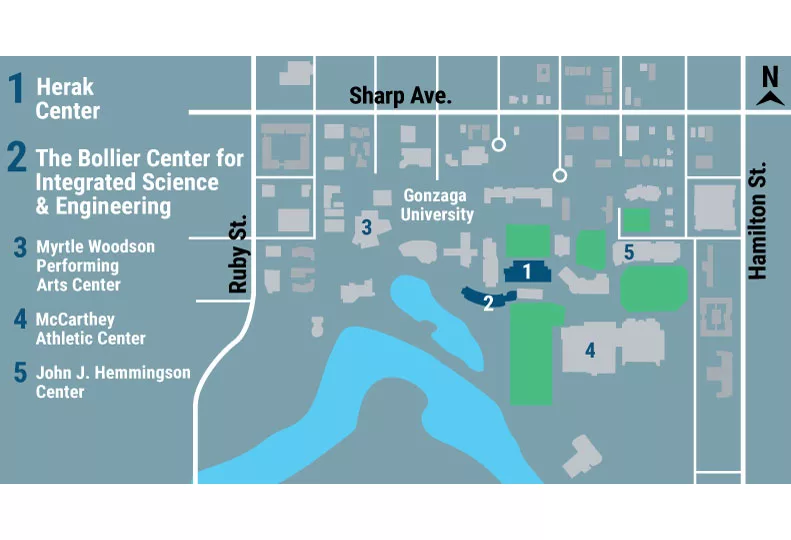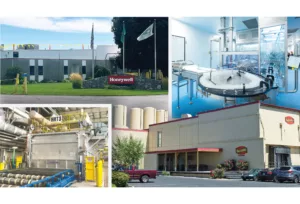Gonzaga invests in high-tech lab upgrades
University creates spaces for two newer programs with $3M in projects

Gonzaga University is investing nearly $3 million to update and modernize learning spaces in two buildings to improve biomedical science, informatics, and research lab space at its Integrated STEM Complex at the heart of its campus in Spokane.
Jennifer Niven Shepherd, interim dean of Gonzaga's School of Engineering and Applied Science, says those projects are creating new physical spaces to support growing academic programs and enhance research capabilities in key high-tech areas.
One project will update the first and second floors of the 82,600-square-foot John & Joan Bollier Center for Integrated Science & Engineering Center. Another project is located on the main floor of the 78,200-square-foot Herak Center for Engineering.
Demolition work has started at both buildings, and the projects are expected to be largely completed by the start of the next academic year, says Niven Shepherd, who also is a chemistry and biochemistry professor.
On the lower level of the Bollier Center, which previously held some study spaces, a dedicated space for the new biomedical engineering program launched last fall will be created, she says. Improvements include a new 1,860-square-foot laboratory suite with a teaching lab, two faculty research labs, and a tissue culture room. The design also incorporates large windows for increased visibility into the labs from an interior corridor.
"Right now, the rooms are hidden because they were unfinished and kind of set aside for future research space," she says. "We're trying to make things as visible as possible."
Gary Weber, director of the engineering management program and assistant professor of mechanical engineering at Gonzaga, says some examples of the potential research to be supported in the new space includes growing heart tissues.
"If you make a new device or material and you want to test it with actual cells ... we could do in vitro-type studies with different types of human cells," explains Niven Shepherd. "They'll have all of the safety precautions in there so that they can work with human cells."
On the second floor of the Bollier Center, the university is planning a Center for Materials Research to support the American Aerospace Materials Manufacturing Center—a tech hub testbed and training center that's expected to be established at the old Triumph Composite Systems Inc. site in Airway Heights, through a collaboration between Coeur d'Alene-based Lakeside Cos., Gonzaga University, and a consortium of about 50 other organizations.
The tech hub consortium is looking to push the envelope on making big thermoplastic composites, which will start small at the Center for Materials Research, Weber says.
Gonzaga's materials center will feature flexible spaces to accommodate a wide range of materials research. Many faculty are interested in that research, and the university was working on the best approach to contribute to the consortium, which prompted plans for a facility to serve the university, the tech hub, and other industry partners that are part of the consortium, say Weber and Niven Shepherd.
Estimated construction costs for both Bollier Center improvements are $2.2 million, excluding costs for lab equipment, which is expect to cost an additional $2.5 million.
North of the Bollier Center, on the first floor of the Herak Center, another project is creating a new home for the new Institute for Informatics and Applied Technology, says Jay Yang, inaugural David & Cathleen Reisenauer Family director of the Institute for Informatics and Applied Technology.
Herak Center improvements are valued at $726,000, according to permit information on file with the city of Spokane.
Spokane-based Walker Construction Inc. is the general contractor for the projects at both buildings, and Integrus Architecture PS, also of Spokane, is designed the projects. Spokane-based MW Consulting Engineers PS is handling mechanical, plumbing, and electrical engineering services.
The informatics institute is an independent entity serving all schools and colleges at Gonzaga, as well as regional, and global partners, Yang says. It focuses on integrating artificial intelligence, machine learning, and data science across the curriculum, including philosophy, English, business, and law, and fostering responsible innovation.
An 1,860-square-foot open office suite will feature a Human-AI Collaboratory, dubbed the HAC Lab, as well as meeting rooms and gathering areas that will accommodate a variety of group sizes and provide flexible spaces for changing needs as they arise, Yang says.
"The ideas is that we're looking into artificial machine learning and data science and how this technology advancement can enable learning innovation," Yang says. "The notion is that humans and AI collab together to innovate, and innovate responsibly, that's the keyword."
Similar to the biomedical laboratory suite, the materials center and the informatics institute also will feature large windows for increased student visibility.
Making these improvements now, at the end of the current school year, is expected to increase interest in the fall for informatics and applied sciences learning, in addition to materials testing and biomedical research activities that will support student research and the tech hub. Class sizes could double in capacity upon completion of the new lab spaces, Niven Shepherd says.
The projects also align with Gonzaga's goals to leverage technology to enhance student learning experiences and to keep campus spaces relevant and updated for modern learning and collaboration, Yang explains.
Weber adds, "Aerospace, biomedical, and artificial intelligence, those are all really at the high-tech forefront and it's exciting to see all projects in each one of those areas coming to Spokane."


_c.webp?t=1763626051)
_web.webp?t=1764835652)

